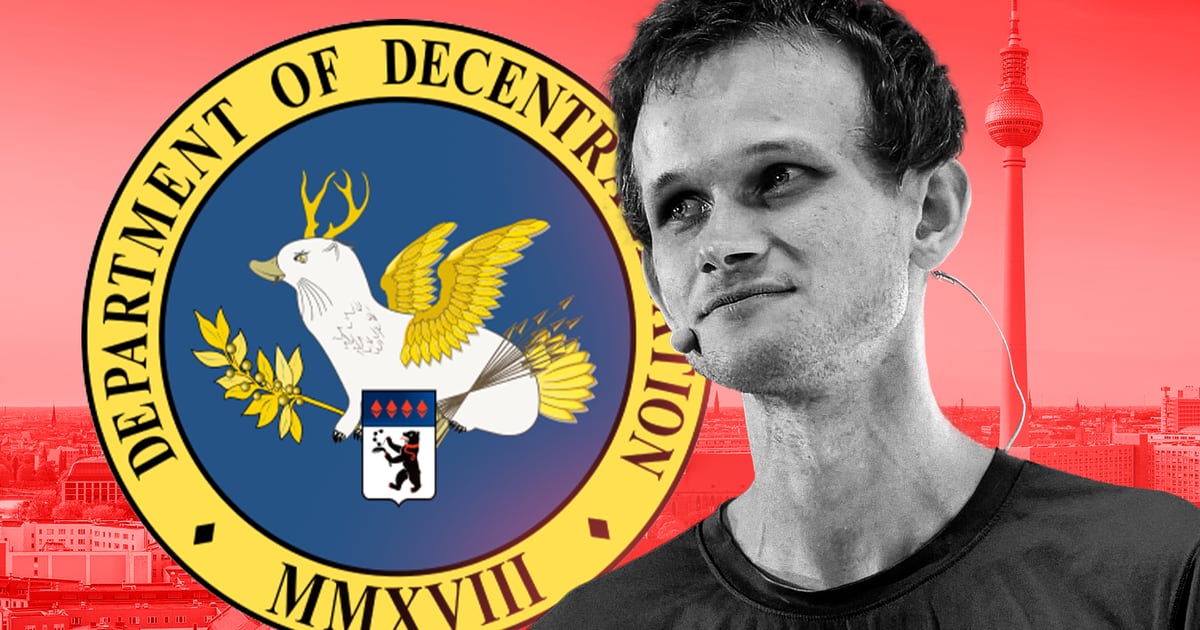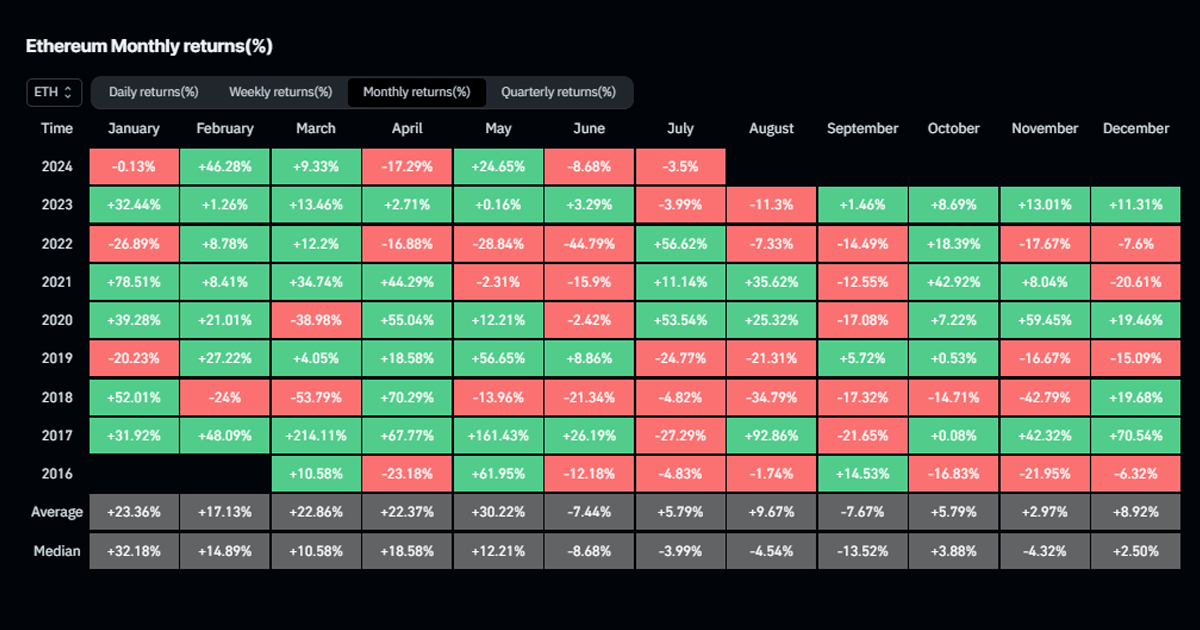Ethereum
Vitalik Buterin reveals five ways to rebuild Ethereum from scratch – DL News

- Ethereum architect shares his thoughts on smart contracts, EVM and other features.
- Buterin says Ethereum developers should have shipped proof of stake sooner.
- Ethereum is becoming more widespread with the advent of ETFs.
When 620 tired developers emerged after three days of non-stop coding at this year’s ETHBerlin event last week, few expected Vitalik Buterin to take the stage.
The co-founder and principal architect of Ethereum was a surprise guest.
What was even more surprising were some of his thoughts on building the second largest blockchain in the industry. Buterin detailed some of the regrets he had regarding Ethereum’s initial design.
For many listeners, his speech not only recalled the halcyon days of the network’s birth in 2014, but it also helped lay out the roadmap for the future of a cryptocurrency now worth $448 billion.
The United States has just approved an Ethereum spot exchange-traded fund, and BlackRock, the world’s largest asset manager, launched its own tokenized fund on the blockchain.
The Ethereum network has given rise to a vast ecosystem of developers and financial applications worth over 63 billion dollarsand it has become synonymous with decentralized finance.
List of things
Still, Buterin, a 30-year-old Canadian-Russian programmer, said he has a list of things he would have done differently. They range from the development of the Ethereum virtual machine to smart contracts and the Proof of Stake consensus mechanism.
And he noted that even as Ethereum becomes more widespread, it remains poorly understood.
Join the community to receive our latest stories and updates
“Bitcoin has a simple narrative which is digital gold,” Buterin said. “But like with Ethereum, it’s like ‘Whoa, what is Ethereum?'”
ETHBerlin04 in numbers 🧮
– 802 super humans in total
– 627 hackers
– 83 project submissions
– 56 volunteers
– 40 experienced hosts
– 33 judges
– 18 mentors
– 15 main teams
– 13 speakers
– around twenty dogs– ETHBerlin04 (@ETHBerlin) May 26, 2024
Sitting on comfortable sofas on stage with ETHBerlin organizers Afri Schoedon and Franziska Heintel, Buterin opened his conversation by sharing his fondest memories of the German capital over the years: hacking in the old office with the co-founders of ‘Ethereum Gavin Wood and Jeffrey Wilcke, launching Devcon. Zero, and celebrating Merge upgrade in 2022.
Then Schoedon asked the question.
“With everything you know and everything you have learned over the last 10 years, how would you build Ethereum differently today if you could start from scratch? asked Schoeden.
Too many songs, too soon
Buterin’s first qualm concerns Ethereum’s virtual machine, which is essential to operating the network as a kind of decentralized crypto megacomputer.
He explained that Ethereum’s original EVM design used 256-bit processing instead of 64 or 32 bits.
In computer architecture, computing size is measured in bits, with larger bits providing better efficiency and processing more data. But 256 bits are very inefficient for most operations and can create a lot of overhead on a blockchain, even for simple tasks.
For a network in its infancy, Ethereum did not need to be optimized for this.
“The original design was way too over-equipped for 256-bit,” Buterin told the audience.
Optimizing smart contracts
Second, Buterin said that early Ethereum developers should have focused on making it easier to write smart contracts with fewer lines of code.
The reason? Added transparency.
With fewer lines of code, he says, “people can properly see and verify what’s going on inside them.”
![]()
Switch to a “shittier” version of staking
Instead of custom computers – called miners – running non-stop to secure a blockchain network, Ethereum has moved to a different model.
Ethereum’s move from one Proof of work consensus mechanism – the way nodes in a blockchain like Bitcoin agree on the state of transaction data – to Proof of Stake in 2022 should have happened much earlier, Buterin said.
“When we moved to Proof of Stake, we should have been prepared to move to a slightly crappier version of Proof of Stake sooner,” he said. “We ended up wasting a lot of cycles really trying to make the proof of stake perfect.”
Instead of miners, Ethereum is now secured by validators who have staked 32 Ethereum, worth approximately $124,000, to do the same thing – and to be rewarded for it. If they behave badly by validating fraudulent transactions for example, they are punished.
In short, the shift replaced raw, energy-intensive computing power with economic incentives.
“We could have saved a huge amount of trees if we had a much simpler proof of stake in 2018,” Buterin said.
Issue logs from day one
From large token transfers to backdoor honeypots, users can track money in crypto quite easily. This is partly thanks to automatic logging.
But as the industry advances, including moving from external accounts like MetaMask to smart wallets like Safe, some aspects of this crucial logging are lost.
In particular, automatic logs for Ether transfers.
“It should have been there from the beginning,” Buterin said. “This could have taken about 30 minutes of coding for me, Gav and Jeff. Instead, it’s an EIP.
Ethereum Improvement Proposals are formal proposals made by developers to change certain aspects of the Ethereum network.
EIP-7708which Buterin submitted on May 17, would bring precisely this change.
![]()
Ditch Keccak
Buterin also said he would have used SHA-2 for Ethereum’s hash function rather than the current function called Keccak.
To understand the difference, you need to delve a little into the history of cryptography, particularly how SHA-3 became a standard. Remember, before crypto became synonymous with celebrity memecoins and nine-digit initial coin offerings, it was complicated math.
When Ethereum was built, the hash used was in a format “hash function competition” – yes, that’s a thing.
The National Institute of Standards and Technology held the competition to create a new hashing standard alongside SHA-2.
Previous standards had been attacked and debunked. But SHA-2 was unscathed and NIST was simply looking for a safe alternative. After all, variety is the spice of life (and apparently crypto).
Keccak was just one of many contestants who entered the competition. During the competition, the team made some minor changes to their algorithms, resulting in them being crowned the winner. In other words: SHA-3.
The first Ethereum team, however, had already implemented a non-standardized version of Keccak. Essentially, Ethereum uses a pre-SHA-3 iteration.
![]()
Big oops, right?
Well, that meant that Ethereum developers needed a custom library – collections of reusable code that didn’t need to be rewritten from scratch – to support both SHA-3 and Keccak.
“We are not compatible with other systems using SHA-3,” said Marius van der Wijden, one of Ethereum’s main developers. DL News. “We need to support both algorithms in the EVM.”
It’s basically resolved. Today, major libraries support both encryption mechanisms.
So yes, big whoop indeed.
“It does not matter in the grand scheme of things and the current development is certainly not affected by it,” van der Wijden said.
The Ethereum Crack Team
Despite the list of minor design errors, Buterin said it’s inevitable that any project will have a few.
“I am really very happy to feel that our core developers and their ability to execute continue to increase year after year,” he said.
“We are able to correct some of these errors efficiently and safely.”
Liam Kelly is a DeFi correspondent at DL News. Do you have any advice? Email to liam@dlnews.com.
Ethereum
QCP sees Ethereum as a safe bet amid Bitcoin stagnation

QCP, a leading trading firm, has shared key observations on the cryptocurrency market. Bitcoin’s struggle to surpass the $70,000 mark has led QCP to predict Selling pressure is still strong, with BTC likely to remain in a tight trading range. In the meantime, Ethereum (ETH) is seen as a more promising investment, with potential gains as ETH could catch up to BTC, thanks to decreasing ETHE outflows.
Read on to find out how you can benefit from it.
Bitcoin’s Struggle: The $70,000 Barrier
For the sixth time in a row, BTC has failed to break above the $70,000 mark. Bitcoin is at $66,048 after a sharp decline. Many investors sold Bitcoin to capitalize on the rising values, which caused a dramatic drop. The market is becoming increasingly skeptical about Bitcoin’s rise, with some investors lowering their expectations.
Despite the continued sell-off from Mt. Gox and the US government, the ETF market remains bullish. There is a notable trend in favor of Ethereum (ETH) ETFs as major bulls have started investing in ETFs, indicating a bullish sentiment for ETH.
QCP Telegram Update UnderlinesIncreased market volatility. The NASDAQ has fallen 10% from its peak, led by a pullback in major technology stocks. Currency carry trades are being unwound and the VIX, a measure of market volatility, has jumped to 19.50.
The main factors driving this uncertainty are Value at Risk (VaR) shocks, high stock market valuations and global risk aversion sentiment. Commodities such as oil and copper have also declined on fears of an economic slowdown.
Additionally, QCP anticipates increased market volatility ahead of the upcoming FOMC meeting, highlighting the importance of the Federal Reserve’s statement and Jerome Powell’s subsequent press conference.
A glimmer of hope
QCP notes a positive development in the crypto space with an inflow of $33.7 million into ETH spot ETFs, which is giving a much-needed boost to ETH prices. However, they anticipate continued outflows of ETHE in the coming weeks. The recent Silk Road BTC moves by the US government have added to the market uncertainty.
QCP suggests a strategic trade involving BTC, which will likely remain in its current range, while ETH offers a more promising opportunity. They propose a trade targeting a $4,000-$4,500 range for ETH, which could generate a 5.5x return by August 30, 2024.
Ethereum
Ethereum Whale Resurfaces After 9 Years, Moves 1,111 ETH Worth $3.7 Million

An Ethereum ICO participant has emerged from nearly a decade of inactivity.
Lookonchain, a smart on-chain money tracking tool, revealed On X, this long-inactive participant recently transferred 1,111 ETH, worth approximately $3.7 million, to a new wallet. This significant move marks a notable on-chain movement, given the participant’s prolonged dormancy.
The Ethereum account in question, identified as 0xE727E67E…B02B5bFC6, received 2,000 ETH on the Genesis block over 9 years ago.

This initial allocation took place during the Ethereum ICOwhere the participant invested in ETH at around $0.31 per coin. The initial investment, worth around $620 at the time, has now grown to millions of dollars.
Recent Transactions and Movements
The inactive account became active again with several notable output transactions. Specifically, the account transferred 1,000 ETH, 100 ETH, 10 ETH, 1 ETH, and 1 more ETH to address 0x7C21775C…2E9dCaE28 within a few minutes. Additionally, it moved 1 ETH to 0x2aa31476…f5aaCE9B.
Additionally, in the latest round of transactions, the address transferred 737,995 ETH, 50 ETH, and 100 ETH, for a total of 887,995 ETH. These recent activities highlight a significant movement of funds, sparking interest and speculation in the crypto community.
Why are whales reactivating?
It is also evident that apart from 0xE727E67E…B02B5bFC6, other previously dormant Ethereum whales are waking up with significant transfers.
In May, another dormant Ethereum whale made headlines when it staked 4,032 ETHvalued at $7.4 million, after more than two years of inactivity. This whale initially acquired 60,000 ETH during the Genesis block of Ethereum’s mainnet in 2015.
At the time, this activity could have been related to Ethereum’s upgrade known as “Shanghai,” which improved the network’s scalability and performance. This whale likely intended to capitalize on the price surge that occurred after the upgrade.
Disclaimer: This content is informational and should not be considered financial advice. The opinions expressed in this article may include the personal opinions of the author and do not reflect the opinion of The Crypto Basic. Readers are encouraged to conduct thorough research before making any investment decisions. The Crypto Basic is not responsible for any financial losses.
-Advertisement-
Ethereum
Only Bitcoin and Ethereum are viable for ETFs in the near future

BlackRock: Only Bitcoin and Ethereum Are Viable for ETFs in the Near Future
Bitcoin and Ethereum will be the only cryptocurrencies traded via ETFs in the near future, according to Samara Cohen, chief investment officer of ETFs and indices at BlackRock, the world’s largest asset manager.
In an interview with Bloomberg TV, Cohen explained that while Bitcoin and Ethereum have met BlackRock’s rigorous criteria for exchange-traded funds (ETFs), no other digital asset currently comes close. “We’re really looking at the investability to see what meets the criteria, what meets the criteria that we want to achieve in an ETF,” Cohen said. “Both in terms of the investability and from what we’re hearing from our clients, Bitcoin and Ethereum definitely meet those criteria, but it’s going to be a while before we see anything else.”
Cohen noted that beyond the technical challenges of launching new ETFs, the demand for other crypto ETFs, particularly Solana, is not there yet. While Solana is being touted as the next potential ETF candidate, Cohen noted that the market appetite remains lacking.
BlackRock’s interest in Bitcoin and Ethereum ETFs comes after the successful launch of Ethereum ETFs last week, which saw weekly trading volume for the crypto fund soar to $14.8 billion, the highest level since May. The success has fueled speculation about the next possible ETF, with Solana frequently mentioned as a contender.
Solana, known as a faster and cheaper alternative to Ethereum, has been the subject of two separate ETF filings in the US by VanEck and 21Shares. However, the lack of CME Solana futures, unlike Bitcoin and Ethereum, is a significant hurdle for SEC approval of a Solana ETF.
Despite these challenges, some fund managers remain optimistic about Solana’s potential. Franklin Templeton recently described Solana as an “exciting and major development that we believe will drive the crypto space forward.” Solana currently accounts for about 3% of the overall cryptocurrency market value, with a market cap of $82 billion, according to data from CoinGecko.
Meanwhile, Bitcoin investors continue to show strong support, as evidenced by substantial inflows into BlackRock’s iShares Bitcoin Trust (NASDAQ: IBIT). On July 22, IBIT reported inflows of $526.7 million, the highest single-day total since March. This impressive haul stands in stark contrast to the collective inflow of just $6.9 million seen across the remaining 10 Bitcoin ETFs, according to data from Farside Investors. The surge in IBIT inflows coincides with Bitcoin’s significant $68,000 level, just 8% off its all-time high of $73,000.
Ethereum
Ethereum Posts First Consecutive Monthly Losses Since August 2023 on New ETFs

Available exclusively via
Bitcoin ETF vs Ethereum: A Detailed Comparison of IBIT and ETHA
Andjela Radmilac · 3 days ago
CryptoSlate’s latest market report takes an in-depth look at the technical and practical differences between IBIT and BlackRock’s ETHA to explain how these products work.
-

 Ethereum12 months ago
Ethereum12 months agoEthereum Posts First Consecutive Monthly Losses Since August 2023 on New ETFs
-

 Regulation12 months ago
Regulation12 months agoCryptocurrency Regulation in Slovenia 2024
-

 News12 months ago
News12 months agoNew bill pushes Department of Veterans Affairs to examine how blockchain can improve its work
-

 Regulation12 months ago
Regulation12 months agoThink You Own Your Crypto? New UK Law Would Ensure It – DL News
-

 Regulation12 months ago
Regulation12 months agoUpbit, Coinone, Bithumb Face New Fees Under South Korea’s Cryptocurrency Law
-

 Regulation12 months ago
Regulation12 months agoA Blank Slate for Cryptocurrencies: Kamala Harris’ Regulatory Opportunity
-

 Regulation12 months ago
Regulation12 months agoBahamas Passes Cryptocurrency Bill Designed to Prevent FTX, Terra Disasters
-

 Regulation12 months ago
Regulation12 months agoIndia to Follow G20 Policy for Cryptocurrency Regulation: MoS Finance
-

 News1 year ago
News1 year ago“Captain Tsubasa – RIVALS” launches on Oasys Blockchain
-

 Ethereum1 year ago
Ethereum1 year agoComment deux frères auraient dérobé 25 millions de dollars lors d’un braquage d’Ethereum de 12 secondes • The Register
-

 News12 months ago
News12 months agoEU supports 15 startups to fight online disinformation with blockchain
-

 News1 year ago
News1 year agoSolana ranks the fastest blockchain in the world, surpassing Ethereum, Polygon ⋆ ZyCrypto












